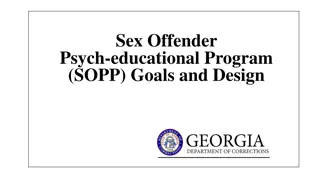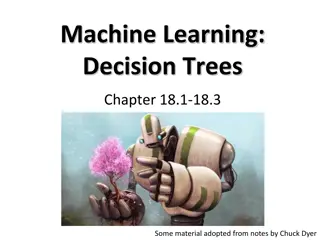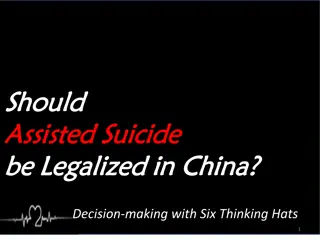Developing Augmented Reality in Youth Offender Learning
The perspective of Romanian youth offenders on developing augmented reality in their learning process.
1 views • 16 slides
Understanding Brain Development and Decision-Making Skills
Explore the fascinating realm of brain development and decision-making skills, focusing on how different brain regions activate during decision-making, the evolution of decision-making abilities from adolescence to adulthood, the importance of practicing decision-making skills, and the influence of
6 views • 10 slides
Transition to a Unified Probation Service: Key Updates and Challenges
The offender management conference 2021 addressed the implementation of a new unified probation service, highlighting changes due to COVID-19, transition challenges, and risks of harm management. The shift towards a new probation operating model aims for full transition between June and September 20
0 views • 21 slides
Enhancing Career Decision Making Process
Explore the importance of good decision-making, types of decision makers, problems faced in decision making, readiness factors for career decisions, decision-making processes, and the CASVE cycle. Understand the significance of effective decision-making skills and how they impact our lives.
0 views • 26 slides
Understanding Fidelity Bonds and Grant Programs in Nebraska
Fidelity bonds, provided through the Federal Bonding Program, offer $5,000 coverage for crimes of dishonesty like theft. Nebraska's Department of Labor received a grant to expand bond usage for individuals with criminal backgrounds, aiding in employment opportunities while reducing hiring risks. The
0 views • 16 slides
Juvenile Court Judges Commission: Enhancing Pennsylvania's Juvenile Justice System
The Juvenile Court Judges Commission in Pennsylvania, comprising nine judges appointed by the Governor, plays a crucial role in providing leadership, advice, and support to improve the state's juvenile justice system. Their mission is focused on community protection, offender accountability, victim
3 views • 18 slides
Understanding the Sex Offender Psych-educational Program (SOPP) Goals and Design
The Sex Offender Psych-educational Program (SOPP) focuses on providing psycho-educational sessions for offenders, emphasizing accountability, harm recognition, and behavior control. The program aims to address the abuse of power inherent in sexual offenses and facilitate discussions on responsible c
1 views • 4 slides
Understanding Confession: Meaning, Types, and Recording Procedure
Confession is a statement by an accused admitting guilt. It serves as proof of the offender's guilt. This article explores the definition of confession, its types, and the procedure for recording a confession. Presented by Abdul Qayyum Siddiqui, a District & Sessions Judge, the discussion delves int
0 views • 32 slides
Probation of Offenders Ordinance 1960: Salient Features
The Probation of Offenders Ordinance of 1960 in Pakistan allows courts to grant probation to eligible offenders, considering factors like age, character, and nature of the offence. Offenders under probation must adhere to specific conditions and can be supervised by a Probation Officer. Failure to c
0 views • 8 slides
Understanding Decision Analysis in Work-related Scenarios
Decision analysis plays a crucial role in work-related decision-making processes, helping in identifying decision makers, exploring potential actions, evaluating outcomes, and considering various values involved in the decision. This module delves into the steps involved in decision analysis, provid
0 views • 76 slides
Understanding Decision Trees in Machine Learning
Decision trees are a popular supervised learning method used for classification and regression tasks. They involve learning a model from training data to predict a value based on other attributes. Decision trees provide a simple and interpretable model that can be visualized and applied effectively.
1 views • 38 slides
Understanding Section 390 of the Indian Penal Code on Robbery
Section 390 of the Indian Penal Code discusses the concept of robbery and its elements of theft and extortion. It outlines that robbery involves imminent danger or the use of violence, and the offender voluntarily causes harm or induces fear to commit the crime. The section also provides explanation
0 views • 7 slides
Enhancing Family Connections for Rehabilitation in Prisons
The Family Support Working Group (FSWG) focuses on supporting familial relationships in prisons to facilitate offender reform and reduce reoffending rates. By prioritizing meaningful connections with family and significant others, positive transformations in prisoners' lives can be achieved, ultimat
0 views • 27 slides
Comprehensive Guide to Decision Making and Creative Thinking in Management
Explore the rational model of decision-making, ways individuals and groups make compromises, guidelines for effective decision-making and creative thinking, utilizing probability theory and decision trees, advantages of group decision-making, and strategies to overcome creativity barriers. Understan
0 views • 30 slides
Understanding the Decision-Making Process
Decision-making is the process of selecting the best course of action from multiple alternatives to achieve desired outcomes. It involves identifying decisions, gathering relevant information, and following a step-by-step process to make informed choices. Principles and steps like identifying the de
0 views • 31 slides
Overview of Education in Minnesota Department of Corrections
Explore the education programs offered at the Minnesota Department of Corrections (DOC) facilities, their mission, vision, and values, as well as future opportunities for offenders. The DOC aims to reduce recidivism through secure incarceration and community supervision, contributing to a safer Minn
0 views • 12 slides
Understanding FIR: First Information Report in Legal Literacy
An FIR is a crucial document in the legal system, essential for reporting cognizable offenses to the police. Learn about the rules for filing an FIR, its key components like victim details, offender description, and the importance of this document in maintaining law and order.
1 views • 5 slides
Introduction to Decision Theory in Business Environments
Decision theory plays a crucial role in business decision-making under conditions of uncertainty. This chapter explores the key characteristics of decision theory, including alternatives, states of nature, payoffs, degree of certainty, and decision criteria. It also introduces the concept of payoff
0 views • 41 slides
Understanding Decision Trees in Machine Learning with AIMA and WEKA
Decision trees are an essential concept in machine learning, enabling efficient data classification. The provided content discusses decision trees in the context of the AIMA and WEKA libraries, showcasing how to build and train decision tree models using Python. Through a dataset from the UCI Machin
3 views • 19 slides
Sentencing Strategies for Child Pornography Cases: Insights & Recommendations
Exploring sentencing strategies for child pornography cases, this resource delves into guidelines, departures/variances, restitution, and conditions of supervised release. It also discusses the offender profile, changes in penalty ranges, and average sentences. The content highlights how sentences h
0 views • 40 slides
Ohio Department of Rehabilitation and Correction: Challenges and Strategies
Recent trends show a complex landscape of prison population growth and budgetary constraints in Ohio. With the prison system operating over capacity and facing fiscal challenges, the state is exploring responses and strategies to manage offender reentry, community sanctions programs, and budgetary r
0 views • 19 slides
Restorative Justice Practices in Responding to Severe Violent Crime by Niall Kearney
This collection of images and information presents insights into restorative justice approaches for severe violent crimes. It discusses the ethical framework, EU guidance, timing considerations, resource utilization, and key stakeholders involved in the process. Also, it highlights the importance of
2 views • 7 slides
Supporting Teenage Young Offender Fathers: A Path to Resettlement
This initiative focuses on supporting teenage young offender fathers in custody and resettlement, addressing the challenges faced by these vulnerable individuals. Through interventions and programs, the project aims to provide guidance, education, and resources to help these fathers navigate parenth
0 views • 16 slides
Enhanced Offender Supervision Through Response & Incentive Matrix
The Response & Incentive Matrix (RIM) aims to provide offenders with fair incentives and violation responses, reducing judicial involvement. It includes tables for incentives and responses based on offender actions. Implementation of RIM leads to consistent actions, immediate rewards, positive behav
0 views • 50 slides
Exploring Restorative Justice in Addressing Campus Sexual Harm
Restorative justice offers an informal approach to addressing campus sexual harm by involving harmed parties, offenders, and others in a collaborative decision-making process. It focuses on holding responsible parties accountable, repairing harm, rebuilding trust, and addressing underlying issues th
0 views • 20 slides
Should Assisted Suicide be Legalized in China? Decision-making with Six Thinking Hats
The content discusses the decision-making process using the Six Thinking Hats method to determine whether assisted suicide should be legalized in China. Various tools and sessions are highlighted, guiding participants through considering different viewpoints, analyzing arguments, and making an infor
0 views • 12 slides
Juvenile Sex Offender Registration and Mandatory Offenses
The content details the requirements and processes related to juvenile sex offender registration, including discretionary removal from the registry, comprehensive evaluations, and mandatory registration for specific offenses. It also lists the mandatory offenses that require registration for juvenil
1 views • 21 slides
NHL Department of Player Safety: Suspension Analytics and Player Offender Data
Explore the NHL's Department of Player Safety analytics on player suspensions since 2011-2012. Discover the most suspended and least suspended teams, reasons for suspensions, injury data, repeat offender definitions, and more.
0 views • 14 slides
Understanding Texas Drug Offender Education Program and DWI Penalties
Explore the Texas Drug Offender Education Program, its course objectives, topics, Controlled Substances Act penalties, DWI penalties, intoxication definition in Texas, additional fines for DWI convictions, and trends in drug use history. Gain insight into the dangers of drug abuse, effects on person
0 views • 67 slides
The Assisted Decision-Making (Capacity) Act 2015 in the Criminal Justice Context
The Assisted Decision-Making (Capacity) Act 2015 introduces key reforms such as the abolition of wards of court system for adults, a statutory functional test of capacity, new guiding principles, a three-tier framework for support, and tools for advance planning. It emphasizes functional assessment
0 views • 17 slides
Implementing Group Decision-Making Tools with Voting Procedures at Toulouse E-Democracy Summer School
Decision-making in organizations is crucial, and group decision-making can lead to conflicts due to differing views. Group Decision Support Systems (GDSS) are essential for facilitating decision-making processes. The Toulouse E-Democracy Summer School discusses the implementation of voting tools in
0 views • 21 slides
Exploring Decision Models in Neural Networks: Population Dynamics, Perceptual Decision Making, and Theory
Dive into the world of decision models in neural networks with a focus on population dynamics and competition, perceptual decision making with V5/MT involvement, and the theory of decision dynamics including shared inhibition and effective 2-dim models.
0 views • 46 slides
Decision Analysis: Problem Formulation, Decision Making, and Risk Analysis
Decision analysis involves problem formulation, decision making with and without probabilities, risk analysis, and sensitivity analysis. It includes defining decision alternatives, states of nature, and payoffs, creating payoff tables, decision trees, and using different decision-making criteria. Wi
0 views • 27 slides
Assessing Offender Risk and Treatment Needs with IORNS
The Inventory of Offender Risk, Needs, and Strengths (IORNS) is a comprehensive tool developed to assess variables related to recidivism. It aims to detect possible changes in these variables through treatment, providing a brief and efficient risk/need assessment with a low reading level. The IORNS
0 views • 33 slides
Decision Making Under Uncertainty Using Decision Trees
In this scenario, Colaco faces the decision of whether to conduct a market study for their product, Chocola. The decision involves potential national success or failure outcomes, along with the consequences of a local success or failure from the market study. By utilizing decision trees, this comple
10 views • 7 slides
Enhancing Decision Making with Information Systems
Explore the role of information systems in enhancing decision-making processes within organizations. Topics include business intelligence, types of decisions, decision-making processes, and managerial roles. Learn about structured, unstructured, and semi-structured decisions, different models of man
0 views • 21 slides
Decision Making and Constitutional Rules Behind the Veil of Ignorance
In decision-making for collective actions, individuals behind a veil of ignorance need constitutional rules to govern future decisions. The choice of rules, the expected external costs, and decision-making costs play a crucial role in determining the optimal decision-making rule. By minimizing total
0 views • 16 slides
Empowering Youth Offender Learning Through Augmented Reality
Augmented Reality (AR) is being utilized in a European Erasmus-funded project to enhance skills and reduce reoffending among young offenders. Led by Shrewsbury Colleges Group, the project aims to provide interactive learning experiences using AR technology, ultimately helping individuals lead law-ab
0 views • 11 slides
Exploring Restorative Justice and Offender Rehabilitation Frameworks
Dr. Tony Ward from Victoria University of Wellington delves into the intersection of restorative justice and offender rehabilitation, proposing a hybrid normative framework for comprehensive practice guidance. He emphasizes the importance of ethical, prudential, and social norms in facilitating mora
0 views • 22 slides
Understanding Empathy Deficits in Offender Interventions
Overview of current practices in offender empathy interventions reveals mixed results and challenges in addressing empathy deficits. Research suggests the need for more person-specific measures targeting cognitive antecedents of empathy rather than generalized treatments. Developing a greater empiri
0 views • 18 slides







































